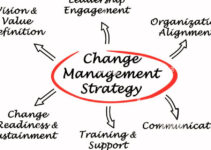A change management plan is a method and approach for businesses and companies to follow in order to implement changes within the organization. Usually, businesses and companies employ change management plans for executing important and complicated changes that demand a strategic approach because it impacts someone else’s job. Today, we’ll discuss a step-by-step guide on how to create an organizational change management plan.
People have different reactions to the changes they perceive. Some people welcome the change and engage in the new processes, and others are reluctant to it. It would make some employees excited, and others don’t at all. One group accepts the changes immediately, and the others don’t accept them at all. However, it doesn’t matter what their views are, it offers a complete roadmap, tools, and support to its employees while implementing the change.
How to Create an Organizational Change Management Plan
Some of the main steps on how to create an organizational change management plan are as follows;
Team Building
As the name implies, it is the process of building the team and developing collaboration, because you can’t do everything by yourself. A change management team consists of various people at different levels of the organization ranging from top to bottom. While implementing change, different people at various levels of the organization would react differently to change. Some of the steps you should keep in mind while team building for change management is as follows;
I-Support from Stakeholders
Every organizational change comprises various stakeholders like employees, executives, the CEO, and other people within the company; ranging from the nature of change. When you have their support and backup in terms of funding, resources, and incentives, then it would amplify the probability of success.
II-Task Force
You should have a team or a task force to launch the organizational change management plan. It is significant to add those people in your task force that is playing the key leadership role in the organization like SMEs and departmental heads. They would educate the rest of the team, answer their questions, and offer support.
III-Necessary Resources
In order to implement the change, you should recognize the key resources that you require for your change initiative; it would help you to avoid delays. For instance, when it comes to training your employees and team members, you would need a sufficient budget and computers to meet your training needs.
Establishing Goals & Objectives
Establishing goals and objectives help you to see where you would like to be at the end of the transition phase. You should know how various changes would impact your customers, clients, business, and your employees, and team members.
I-Recognizing Change
It is significant to recognize the changes and comprehend what it means, and how they would impact your business. For instance, if you are launching new software for your employees and workforce, then it is not sufficient to inform them that it is software, and let’s start using it. You should recognize and understand the fact that how the new change of software would impact the current workflow of processes.
II-Adopting Change
Spreading employee awareness and making them adopt the changes is a very important part of the organizational change management plan. You have to make sure to add them to your goals and objectives.
III-Setting KPIs
In order to measure the performance and success of your plan, it is significant to set KPIs. You can employ a variety of metrics and tools for evaluation, and use any such tool that makes sense to you relevant to your change plan. For instance, you’re employing reports as KPIs to analyze the application of the new software, to study customer feedback, and statistics of employees whether the changes have amplified productivity or not.
Developing a Plan
After building a team and establishing the goals and objectives of the change plan, it is time to develop a plan for your change program. Some of the steps you should keep in mind are as follows;
I-Task List
Tasks are the smaller subdivision of the goals and they would help businesses and companies to achieve their goals and objectives. It is significant to create a list of tasks that you need to perform for your change implementation program. However, some of them are training, documentation, getting feedback, communication, and others.
II-Setting Timeline
It is important to attach a specific timeline or a date for your change program, and your organizational change plan should follow that timeline. You attach a timeline to every task in your checklist. If you cannot complete some particular tasks after implementing the changes, then you should adjust the timeline. If you don’t have the option of changing the date or timeline, then you should know the various tasks that you can or cannot complete on time; prioritize their time schedule accordingly.
III-Employing Project Management Tools
Implementing change management is a difficult task, and you should employ various tools and software for the success of your change initiative. You should create a list of tasks, allocate resources and team members for every task, and analyze the performance within the software. It becomes much easier to track the performance, generate reports, and send them to all the relevant stakeholders.
Start Implementing
Creating an organizational change management plan is just the beginning of the process, and it is now time to start executing the change process. While implementing the change, some of the steps you should keep in mind are as follows;
I-Decision Making Process
You can’t predict the results before implementing the changes, because issues and problems are bound to show up. For instance, some changes impact your workflow that you haven’t thought of before, and that’s why you should have a speedy decision-making process to resolute the problem immediately. Therefore, it is significant that you should have a proper decision process to deal with various types of issues.
II-Developing Momentum
In order to improve the confidence of your employees, it is significant that you should let them know that the transformational changes are working and succeeding. It would be helpful if you offer them incentives for implementing the changes, or give them a party for adopting the new software. However, it allows you to build their momentum behind the scene, improve their emotional energy, and develop a cultural willingness to accept the change.
Facilitate Change Initiative
After successfully implementing the changes, it doesn’t mean that you should let team members and employees go. It is significant that you should facilitate the change program; it would motivate employees to transform their behavior and attitude towards the new change initiatives.
I-Positive Incentives
If the company’s leadership executes the change program forcefully, then it would cause resentment and frustration among them. The most effective and efficient approach is to offer them positive and attractive incentives if they like the change initiative. You can upgrade the difficult processes and make it easier for them, it would be a great incentive for them. It means that they are making adjustments in their plans to reward their employees for accepting the change.
II-Meetings Regularly
During the transition phase, many people would have questions and concerns, and only a training program is not sufficient. When management meets with its employees regularly and offers support and assistance, they would feel confident that they would accept the change.
III-Reviewing
After implementing the change, it is significant to review the performance of your team members regularly and motivate them to adopt the change. For instance, if you have upgraded the workflow and it didn’t go as planned after implementing the changes. You should make some necessary adjustments relevant to the real-life date; it would establish greater team confidence and acceptance during the transition phase.
Prepare for Resistance
Not everyone in the organization would welcome the change. Some of them would resist the idea of change; your reaction would define how your employees should respond to the change. You should have a proper resistance plan if it arises.
Conclusion: Organizational Change Management Plan
After an in-depth study of organizational change management plan; we have realized that change management plan is highly significant for your organization. If you’re developing a change plan for your organization, then you should keep in mind the abovementioned step-by-step guideline.
Ahsan is an accomplished researcher and has a deep insight in worldly life affairs. He goes Live 3 days a week on various social media platforms. Other than research writing, he’s a very interesting person.


